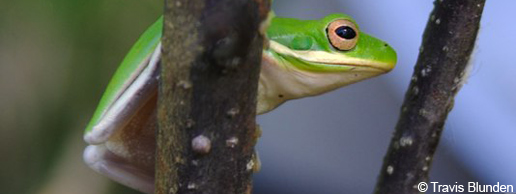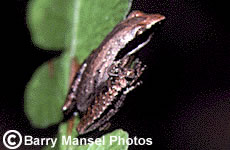
Little Grass Frog
Pseudacris ocularis / Limnaoedus ocularis

Distribution: It is found throughout Florida, except in the westernmost panhandle.
Description: Its characteristic marking is a dark line passing through its eye and extending down the length of its body. The length of this line may be variable, but it is always present. Generally, its coloring is tan, brown, green, reddish or pink. A dark, narrow stripe separates its body color from the lighter coloring of its sides. Another dark, narrow stripe may extend from a triangle-shaped spot between the eyes to the end of its body. Its chest is either white or yellowish in color. The habitat of the little grass frog includes grassy ponds, marshes, and shallow, often temporary, bodies of water. It is usually in clumps of grass where it is well hidden.
Habitat: It is often found perched on grass stems, usually positioned just above the water surface and up to 2 feet above the water. This frog is very difficult to locate because it often aligns itself with the stem on which it is sitting, and its striped pattern allows it to blend in with the surroundings.
Size: The little grass frog is the smallest of all North American frogs, ranging is length from 7/16 to 5/8 of an inch.
Reproduction: Their breeding season correlates with rainy times of year (winter/early spring in northern Florida and spring/summer/fall in sourthern Florida).
Call: The little grass frog's call is described as a tinkling sound or a high-pitched chirp, similar to the call of insects such as a tree cricket. It may be heard throughout most of the year. They also sing during both the day and the night.
Development of these pages was a cooperative effort. Photos were supplied by Barry Mansell Photos and calls were provided by Paul Moler, state herpetologist for the Florida Fish and Wildlife Conservation Commission.


 Location: http://yourdomain.edu
Location: http://yourdomain.edu